
Newgate Prison was a prison at the corner of Newgate Street and Old Bailey Street just inside the City of London, England, originally at the site of Newgate, a gate in the Roman London Wall. Built in the 12th century and demolished in 1904, the prison was extended and rebuilt many times, and remained in use for over 700 years, from 1188 to 1902.
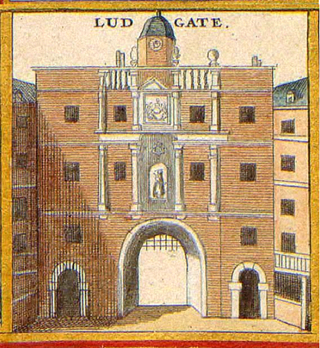
Ludgate was the westernmost gate in London Wall. Of Roman origin, it was rebuilt several times and finally demolished in 1760. The name survives in Ludgate Hill, an eastward continuation of Fleet Street, Ludgate Circus and Ludgate Square.
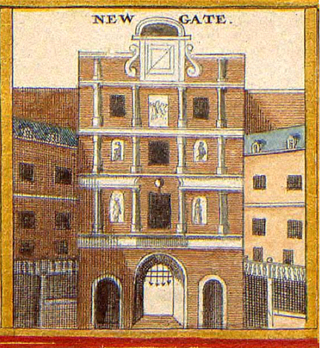
Newgate was one of the historic seven gates of the London Wall around the City of London and one of the six which date back to Roman times. Newgate lay on the west side of the wall and the road issuing from it headed over the River Fleet to Middlesex and western England. Beginning in the 12th century, parts of the gate buildings were used as a gaol, which later developed into Newgate Prison.

Borough High Street is a road in Southwark, London, running south-west from London Bridge, forming part of the A3 route which runs from London to Portsmouth, on the south coast of England.

The Clink was a prison in Southwark, England, which operated from the 12th century until 1780. The prison served the Liberty of the Clink, a local manor area owned by the Bishop of Winchester rather than by the reigning monarch. As the Liberty owner, the Bishop kept all revenues from the Clink Liberty, and could put people in prison for failing to make their payments. As the Bishop, he could also imprison heretics. The Clink prison was situated next to the Bishop's London-area residence of Winchester Palace. The Clink was possibly the oldest men's prison and probably the oldest women's prison in England.
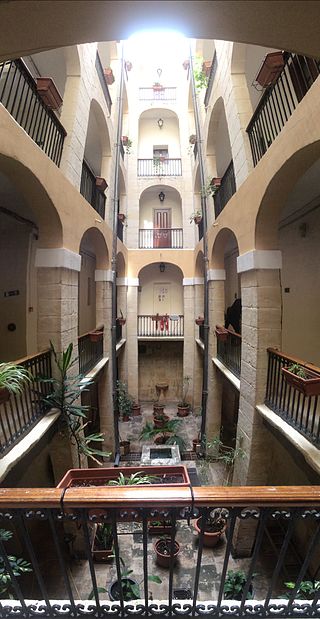
A debtors' prison is a prison for people who are unable to pay debt. Until the mid-19th century, debtors' prisons were a common way to deal with unpaid debt in Western Europe. Destitute people who were unable to pay a court-ordered judgment would be incarcerated in these prisons until they had worked off their debt via labour or secured outside funds to pay the balance. The product of their labour went towards both the costs of their incarceration and their accrued debt. Increasing access and lenience throughout the history of bankruptcy law have made prison terms for unaggravated indigence obsolete over most of the world.

The King's Bench Prison was a prison in Southwark, south London, England, from medieval times until it closed in 1880. It took its name from the King's Bench court of law in which cases of defamation, bankruptcy and other misdemeanours were heard; as such, the prison was often used as a debtor's prison until the practice was abolished in the 1860s. In 1842, it was renamed the Queen's Bench Prison, and became the Southwark Convict Prison in 1872.
A compter, sometimes referred to as a counter, was a type of small English prison controlled by a sheriff. The inmates were usually civil prisoners, for example dissenters and debtors. Examples of compters include London's Wood Street Compter, Poultry Compter, Giltspur Street Compter and Borough Compter and the lock-up over the Abbey Gateway, next to St Laurence's church, in Reading, Berkshire.
The Borough Compter was a small compter or prison initially located in Southwark High Street but moved to nearby Tooley Street in 1717, where it stood until demolished until 1855. It took its name from 'The Borough', a historic name for the Southwark area of London on the south side of the River Thames from the City of London. This replaced a lock-up as part of the City's court house under the jurisdiction of the Lord Mayor and Court of Aldermen of the City, and their High-Bailiff of Southwark. This first court house was converted from the old church of the parish St Margaret. A floor was made across the level of the church's gallery and the windows below that were blocked in, the Court Room being on the first floor. This structure was destroyed in the Great Fire of Southwark in 1676.

The Giltspur Street Compter was a compter or small prison, designed by English architect and surveyor George Dance the Younger, mainly used to hold debtors. It was in Giltspur Street, Smithfield, close to Newgate, in the City of London, between 1791 and 1853.

Giltspur Street is a street in Smithfield in the City of London, running north–south from the junction of Newgate Street, Holborn Viaduct and Old Bailey, up to West Smithfield, and it is bounded to the east by St Bartholomew's Hospital. It was formerly known as Knightsriders Street, from the knights riding at the tournaments in Smithfield.

Poultry Compter was a small prison that stood at Poultry, part of Cheapside in the City of London. The compter was used to lock up minor criminals and prisoners convicted under civil law and was run by the City's Sheriff. It operated from the 16th century until 1815. It was pulled down in 1817 and replaced with a chapel.

St. Mary Staining was a parish church in Oat Lane, northeast of St. Paul's Cathedral, in the City of London. First recorded in the 12th century, it was destroyed in the Great Fire of London in 1666 and not rebuilt.
St Benet Sherehog, additionally dedicated to St Osyth, was a medieval parish church built before the year 1111, on a site now occupied by No 1 Poultry in Cordwainer Ward, in what was then the wool-dealing district of the City of London. A shere hog is a castrated ram after its first shearing.

The Marshalsea (1373–1842) was a notorious prison in Southwark, just south of the River Thames. Although it housed a variety of prisoners, including men accused of crimes at sea and political figures charged with sedition, it became known, in particular, for its incarceration of the poorest of London's debtors. Over half the population of England's prisoners in the 18th century were in jail because of debt.
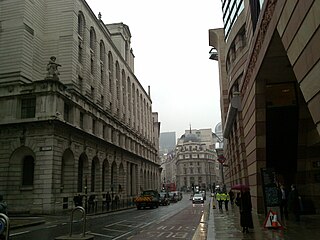
Poultry is a short street in the City of London, which is the historic nucleus and modern financial centre of London. It is an eastern continuation of Cheapside, between Old Jewry and Mansion House Street, towards Bank junction.
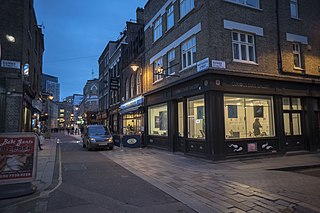
Whitecross Street is a short street in Islington, in Inner London. It features an eponymous street market and a large housing estate.

Russia Row is a street in the City of London that runs between Milk Street and Trump Street on the northern side of the former Honey Lane Market. Russia Court, formerly Robin Hood Court, the home of the Russia Company, was once located on the northern side of the street and the City of London School on the south side. The street is thought to have received its name around 1804, shortly before Russia decided to enter the Napoleonic Wars on the same side as Britain. It was damaged by German bombing during the Second World War and has since been completely rebuilt.

Milk Street in the City of London, England, was the site of London's medieval milk market. It was the location of the parish church of St Mary Magdalen which was destroyed in the Great Fire of London in 1666 and then of Honey Lane Market and the City of London School. The street was seriously damaged by German bombing during the Second World War and has since been completely rebuilt. Nothing remains of its former buildings.
Richard Vennar was an English writer, known particularly for his attempt to stage his play England's Joy.

















